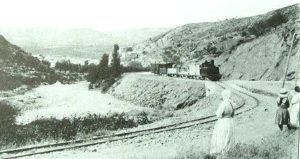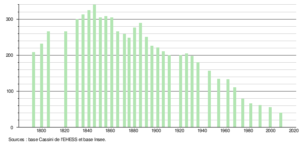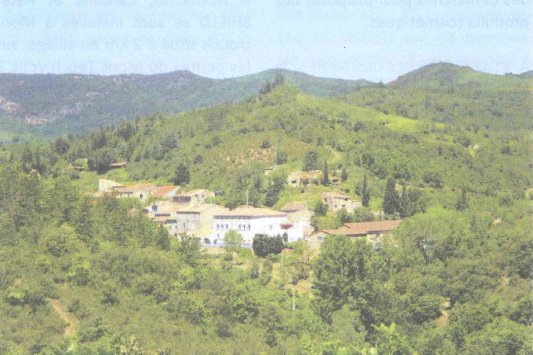The economic decline of the Maisons and the Hautes Corbieres has been in progress for over a hundred and fifty years, the final nail in the traditional rural economy was the post War industrial boom, but the decline has deep roots back into the mid 19th century. Today the Aude now ranks as Metropolitan France’s second poorest Department, with the Hautes Corbieres as one of the poorest parts of the department.
Understanding how this happened you need to take into account the impact on the people of Maisons of the opening up of the local economy to a larger market and the impact that had on local agriculture, the changing nature of the French labour market, as well as technological advancements.
Maisons is a relatively isolated village, today situated in the Canton of Tuchan on the border with the Canton of Mouthemet. Maisons sits at the foot of Mont Tauch with the Hautes Corbieres massif to it’s back. At 320 metres, the commune’s 1215 hectares stretches from the top of the 800m summit of Mont Tauch, down the mountain’s western slopes and up the Mouthemet massif.
At the start of the 19th century Maisons’s, then 266, inhabitants existed on a mixed subsistence agricultural economy, aided by the continued exploitation of small mining concerns that had continued from their start in Roman times. The land between the village and the La Valette, the stream that descends from the Hautes Corbieres, was used as market gardens growing all the vegetables and fruit consumed in the village. The 1835 cadastral plan shows three mills situated along La Vallette who ground the cereals, such as wheat, grown around the village and at Montrouch. Roughly half the land worked was used to grow fodder for animals, primarily work horses, cattle and pigs. the same cadastral plan also shows 27 bergeries, shepherd’s buildings, in the commune highlighting the importance of sheep and goats to the local economy.
Forestry, represented one of the few hard currency exports of the village. After the devastation of the forests of the Corbieres due primarily to the mining and forges (See Mines des Corbieres) in the century before following the French Revolution ( See History of the Garrigue and Revolution and Environment) the Second Republic instigated a massive tree replanting programme across the Languedoc, one of the principal consumers were the naval yards along the coast.
The last part of the local economy was of course the mines. Discovered in Roman times, gold and silver were mined on the massif between Maisons and Palairac until the Middle Ages. Reopened in the early 19th century a handful of mines yielded some more silver, but iron primarily copper and lead, and later antimony and magnesium. This reopening probably accounts for the population high point of Maisons in 1846 when the village boasted a dizzy 339 souls. The last mining concession, La Mine du Canal opened in 1838 and can still be seen today, although all the others have now been sealed off.
The late 19th century saw the gradual replacement of cereal production with vines, however the total land under production started to shrink rather rapidly. By 1913 the worked land had fallen to 288 hectares, this was to drop to 133 in 1947, 98 in 1949, 87 in 1985 and 51 in 2001.
 The replacement of subsistence crops with revenue crops, which is what the transition from cereals to vines represents was made possible by the extension of railways. The railways made transportation of wine both possible and affordable, a crucial factor particularly for the rough and ready down market wines like the Corbieres of the epoch. By the early 20th century there was a train line that connected Lezignan Corbieres with Tuchan (1902), and a second line ran to Mouthemet (1905). Both railheads were in reach by cart from Maisons. (This is an interesting history of the Corbieres trainline from Thezan Corbieres ).
The replacement of subsistence crops with revenue crops, which is what the transition from cereals to vines represents was made possible by the extension of railways. The railways made transportation of wine both possible and affordable, a crucial factor particularly for the rough and ready down market wines like the Corbieres of the epoch. By the early 20th century there was a train line that connected Lezignan Corbieres with Tuchan (1902), and a second line ran to Mouthemet (1905). Both railheads were in reach by cart from Maisons. (This is an interesting history of the Corbieres trainline from Thezan Corbieres ).
However vines did not prove the saving grace many had hoped for. Although the number of vines grew, from 110 hectares in 1913 to 143 in 1949 so did the size of fallow agricultural land, from 562 hectares in 1913 to 718 in 1949.
In 1946 the 64 vignerons of Maisons worked an average of 3.5 hectares of vines with only one working 8 hectares and another 11. The small size of these grape growers, although aided by the village Cave Cooperative for transforming the grapes into wine and marketing meant that for most growers, vines represented an additional income and not a principal revenue. A family cannot live on the income from 3.5 hectares of vines.
Animal husbandry also suffered a massive decline, from 27 shepherds in 1836 by 1898 the herds had shrunk to 900 sheep, 40 pigs and two cows, 50 years later this has dropped to 18 pigs and 80 goats.
 From its high point of 339 in 1846 the population of Maisons has been in steady decline ever since. In 1901 the village stood at 221 souls, in 1946 it had dropped to 157. The most important drop however has been post war. In the last 60 years the village population has plummeted to less than 30 inhabitants, with the majority of our population aged over 70 years old.
From its high point of 339 in 1846 the population of Maisons has been in steady decline ever since. In 1901 the village stood at 221 souls, in 1946 it had dropped to 157. The most important drop however has been post war. In the last 60 years the village population has plummeted to less than 30 inhabitants, with the majority of our population aged over 70 years old.
The post war transformation of the French economy spelt the end of the Hautes Corbieres, with ‘marginal’ agricultural land that was not easily worked with mechanical farm machinery. The farmers of the area were unable to compete with the increasingly mechanised agriculture of the plains. In addition to this ‘push’ factor of low and variable income was the massive pull factor of readily available work in the factories of the North that offered an easier and more reliable revenue. The young of remote villages such as Maisons migrated towards the towns of the plains and the cities of the North leaving their parents to work the vines. As the parents retired there were no new arrivals to take over their farms and vineyards and the land slowly fell out of production. In Maisons there now remains one sole vineyard.
Link Maire du Maisons https://sites.google.com/site/maisonsaude/home

